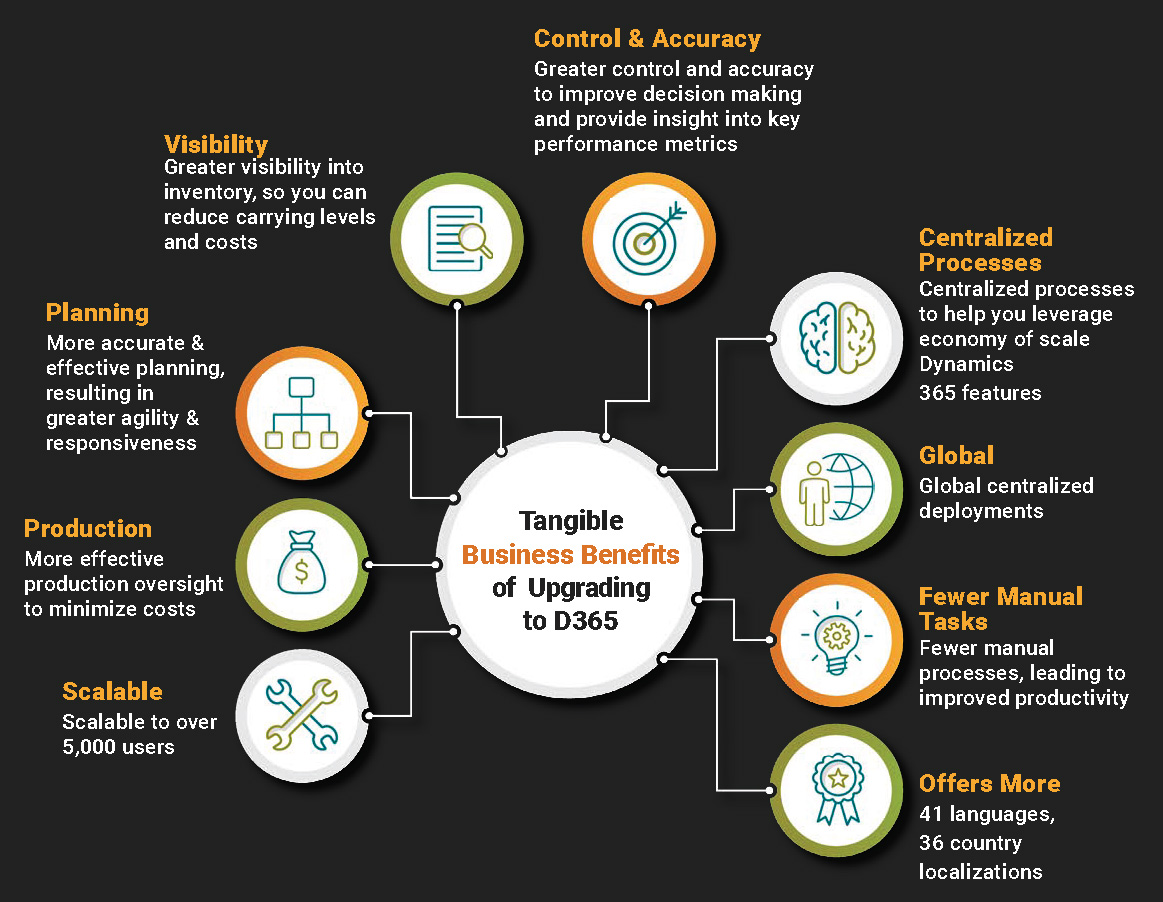
Whether you’re expanding your product lines, offering new services, expanding globally, increasing the number of partners you work with or acquiring another company, all are harbingers of company growth and success. But there can be a downside: Your business may no longer be aligned with your enterprise resource planning (ERP) software.
Often this means you no longer have the confidence, control or visibility you need to manage operations effectively. A few warning signals that your company has outgrown its ERP system include less flexibility and slowed responsiveness, and inability to go to market quickly enough with new products and services.
That’s why, if you’re using on-premises software today and are actively growing or have grown your business, it may be high time to move up to Microsoft Dynamics 365 for Finance and Supply Chain (formerly known as Dynamics 365 for Finance and Operations). Named a Leader in Gartner’s ERP Magic Quadrant, Dynamics 365 is Microsoft’s enterprise ERP solution designed for expanding companies like yours.
And because it’s the natural next step for growing organizations, the business case for moving to D365 can be quite compelling. Read on to find out if Dynamics 365 for Finance and Supply Chain is the right choice for upgrading your ERP system, and how you can complete a smooth transition using our proven Upgrade Roadmap.
Your company is growing in revenues, locations and/or product or service lines.
You’re moving into international markets and need to support multiple currencies, languages and regulatory reporting requirements.
It takes longer to get things done. Managers do not get timely information to make decisions due to increased manual processes. You have compliance requirements that are being managed outside the system.
Your staff is relying more on third-party applications, custom code and paper-based processes. Rather than bridge gaps, these offline business processes create new blind spots and silos of information.
Your spreadsheet application has become a fallback tool for too many critical areas.
There has been, or will be, an acquisition or merger.
Products, product lines and pricing have become more complex.
You don’t have timely access to critical performance metrics, financial data or other critical information. Month-end processes keep taking longer and regulatory reporting continues to increase.
When you think about it, an ERP system that is no longer able to help your company thrive and grow is costing you far more than what you pay for software installation and maintenance. Consider the labor and operating costs associated with inefficiency throughout the organization. Costs stemming from excess inventory due to a lack of visibility can hurt your bottom line. An inability to respond in a timely way to customer and management requests may result in lost opportunities or create openings for competitors to get a toehold in your customer base.
So, while replacing your accounting/ERP system obviously requires an investment in time and money, the return on that investment can be quite substantial. For instance, by moving to a system such as Dynamics 365 for Finance and Supply Chain, you gain the capabilities you need for your growing company, including greater scalability, more visibility and better control across the entire organization.
That’s not all. If your company is using multiple software packages to handle processes covered by the much broader and deeper functional footprint of Dynamics 365, you can consolidate many or all these systems into one. This gives you a single source of truth for your business while eliminating duplication of effort, reducing errors and improving productivity and collaboration across departments. In addition, your company may end up paying less in license and maintenance fees for a new ERP system than it currently pays for multiple disparate systems.
Another example of consolidation that can benefit your bottom line is when your company is running multiple instances of on-premises across different divisions or companies. This can make it difficult and time-consuming to maintain master data such as general ledger accounts, inventory items, vendors, customers and more across different databases and systems. There is duplication of effort just to keep records synchronized. Consolidating these systems eliminates data re-entry and gives you better visibility and control across the entire enterprise with intercompany transactions and consolidated reporting.
Building the business case for upgrading your ERP can be an eye-opening exercise, shedding light on constraints and workarounds that keep your business from realizing its full potential.

Total cost of ownership is another important aspect of the business case. When you are deciding whether to upgrade, a major part of that decision is choosing the new ERP system. This decision has a direct impact on your business case since it can dramatically impact your total cost of ownership and return on investment.
Start by evaluating the capabilities you need in the new ERP system. Realizing that the right ERP software can be transformative for your business, you’ll want to insist on one that is designed for growing companies that need support for:
Microsoft Dynamics 365 for Finance and Supply Chain delivers all these capabilities and more. Designed for enterprise organizations, Dynamics 365 is purpose built for manufacturing, distribution, retail, public sector and services organizations.
For companies that evolve from a business model centered on manufacturing to one involving distribution, retail and/or professional service offerings, Dynamics 365 can continue to grow with the business. It provides rich, end-to-end business process support, including finance; supply chain; manufacturing; manufacturing resource planning (MRP); AI-driven demand planning; advanced warehousing and transportation management; customer relationship management (CRM); asset management; human resources; and governance, risk and compliance.
While you may be considering other enterprise-class ERP systems that deliver some of these capabilities, it’s important to understand that if you are a Microsoft on-premises customer, there is a compelling business case for moving to Dynamics 365 for Finance and Supply Chain:
Both systems utilize transferrable skill sets around the Microsoft platform, including SharePoint, Power Platform, Office, SQL Server & more, so your IT staff will easily transition to supporting Dynamics 365.
You’ll continue to receive full support for Dynamics GP during your transition.
With a familiar user interface and the same technical skill set needed, you reduce your risk of project delay and failure.
The final reason why the total cost of ownership and return on investment is definitively better when moving from on-premises to Dynamics 365 for Finance and Supply Chain, rather than a different enterprise ERP system, is that there is a clear and proven transition path. It’s not a complete rip-and-replace; rather, it’s a progression to expanded capabilities. That means you can move faster, more smoothly and with less risk.
Any software upgrade can cause disruption, but because your ERP system touches many people and processes throughout your organization, it’s even more critical to minimize business interruptions and risk. That’s why we created our Upgrade Roadmap.
The Armanino On-Premises to the Cloud Upgrade Roadmap helps ensure a smooth transition from your On-Premises to the Cloud for Finance and Supply Chain. Based on years of experience helping customers successfully deploy both software packages, it is a proven methodology for migrating companies that have outgrown their current ERP implementation.
Armanino manages expectations throughout, explaining benefits and making recommendations to ensure changes are as seamless as possible. Everyone will feel informed and involved in the successful transition.
We help you gain a clear picture of your existing footprint of ERP and related systems, as well as a clearly defined scope that reduces the chance of surprises during the project.
We uncover previous limitations and help you improve processes when moving to the new system. We view the transition as the ideal opportunity to apply best practices and lessons learned from our years of industry and Microsoft Dynamics experience, to help you streamline processes and ready your organization for realizing your business strategies now and in the future.
Armanino utilizes automated data transformation tools and provides guidance to help make the conversion of your data from your previous system to Dynamics 365 as straightforward and painless as possible.
Our Dynamics GP and D365 experts translate and compare terminology and processes between the two software packages to help your staff make the switch quickly.
We work hand in hand with your teams to ready them for the transition and help them be quickly productive using the new system. Our workshops are designed to build understanding and transfer knowledge from our experts to your staff in a way that eases the pain of change and highlights the benefits to your employees of mastering new capabilities. This is a critical component to ensure adoption and success of your new ERP system.
As one of the largest Gold Certified Microsoft Dynamics Implementation Partners in the country, Armanino offers the structure, methodology, resources, experience, training and tools to ensure your company’s success in upgrading to Dynamics 365.
If your company is starting to show the signs of outgrowing your On-Premises Solution, look to Armanino for objective guidance on upgrading your ERP to support your growth and enable competitive advantage.
Here’s why clients choose Armanino for their On-Premises to the Cloud upgrades:
Building the business case for upgrading your ERP can be an eye-opening exercise, shedding light on constraints and workarounds that keep your business from realizing its full potential.


